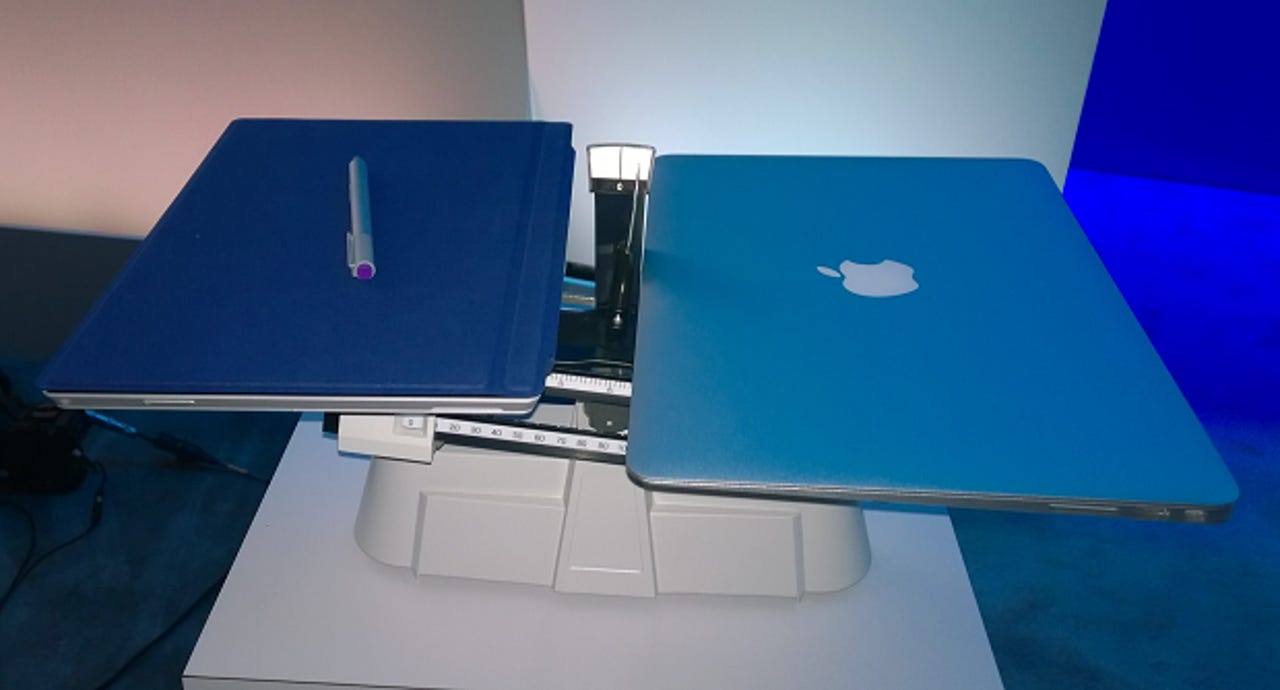Surface Pro 3: Thinner, lighter, more flexible

With the Surface Pro 3, Microsoft isn’t shying away from a fight. The latest entry in the Surface line, introduced this week at a press event in New York City, takes dead aim at the ultra-premium, ultralight segment currently dominated by Apple’s MacBook Air.

On paper, it’s not even close to a fair fight, as the new Surface wins on almost every score. But the market doesn’t pick winners and losers by looking at spec sheets. And the Surface Pro 3, while undeniably brilliant in design and execution, is still also undeniably quirky. Microsoft calls it "the tablet that can replace your laptop." Whether laptop buyers are ready to make that leap is an open question.
I took a loaner Surface Pro 3 home from today’s event. Here are some first impressions, after just a few hours of use.
This thing is ridiculously light. The only onstage prop at today's event was an old-school mechanical scale (shown in the photo above). With the Type Cover and included pen, the Surface Pro 3 is still 180 grams (about 6.5 ounces) lighter than the 13-inch MacBook Air.
That achievement is even more impressive when you realize the new Surface Pro has a 12-inch (diagonal) display with a 2160x1440 native resolution. That's significantly larger than the 10.6-inch, 1920x1080 display on the Surface Pro 2. And yes, that's a 3:2 aspect ratio rather than the 16:9 ratio of a typical laptop. The resulting display feels much more natural in the hand when held in portrait mode, where its dimensions are downright paper-like.
Read more
The two previous iterations of the Surface Pro were uncomfortably thick. This edition is impossibly thin, especially when you consider that's an Intel Core i5 processor inside. Yes, there's a fan, but it's a custom design that expels air in literally every direction through the thin vents that completely surround the tablet's magnesium case. I couldn't hear the fan or feel any air even when pushing the CPU.
Several signature Surface features get significant changes in this edition. The kickstand, which was limited to a 22-degree angle in the Surface Pro and added a second angle in the Surface Pro 2, now uses a friction hinge that can stop at any angle from zero to 150 degrees. Fully extended, it props the top edge of the display up by just a couple inches, ideal for viewing movies.
The power supply has a completely new magnetic connector that replaces the sometimes-balky five-pin design of earlier Surfaces. (On the downside, that means those old power supplies won't work with the new model, and vice versa.)
The trackpad, another source of complaints, is completely redesigned in the $129 Type Cover for Surface Pro 3. In my brief testing it was smooth and accurate.
Previous Surface Pros included a Wacom digitizer with pen. The Surface Pro 3 uses an N-Trig digitizer and a pen that pairs via Bluetooth. The pen (included with every edition) requires a battery and is stored in a small loop at the left side of the Type Cover.
The pen has a clever button at top that works like a remote control. Tap that button once, as if clicking a ballpoint pen, and it wakes up the device and loads Microsoft OneNote. In the onstage demo, a double-tap of the pen button saved the current screen to OneNote, allowing quick sharing and editing, a feature I didn't test.
The biggest stumbling block for some would-be buyers is going to be that kickstand, which is far more flexible than before but still will feel more awkward in the lap than a conventional clamshell design. (There's a reason they call them laptops.) Another design change that helps is a tiny tweak to the Type Cover, whose top edge now flips up and clamps to the bottom bezel of the display magnetically. That makes the keyboard significantly more rigid and adds some ergonomic tilt as well.
One feature that I wasn't able to test is the performance of the 42 watt-hour battery, which reportedly can last for nine hours of steady use and, more importantly, can hold its charge in standby mode for up to a year.
If you liked the earlier iterations of the Surface Pro you'll no doubt love the changes in this, the third edition. If you were put off by the Type Cover or the heft of earlier versions, the improvements here make it well worth a fresh look.
The real question is whether there are enough well-heeled buyers out there willing to pay the premium price for a Surface Pro instead of a MacBook Air. The lighter weight, sharper display, and touch support are pluses for the Surface. But they might not be enough to convince traditionalists to give up that familiar laptop form factor.
Related Coverage:
- 7 good Windows hybrids that rival the Surface Pro 3
- What's right (and wrong) with the Microsoft Surface Pro 3
- Microsoft Surface Pro 3: Can the execution match the message?
- Microsoft tablets through the ages: The good, the bad and the ugly, in pictures
On CNET: